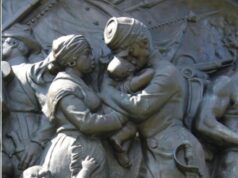by Adam Siegel
Part of the challenge of fostering better paths forward, across myriad issues but certainly in terms of improved race relations, is open engagement with and learning from the past (as prelude). American University has, with the “Plans to Prosper You” exhibit, provided a useful example of how a university community (professors, students, archivists, curators) can work to advance education and advance better understanding of the communities they are part of. When considering the AU Museum exhibit about three ‘hidden’ Montgomery County, MD, black communities, it seems that this could be a useful template for Virginia universities and university museums for local engagement and enrichment.
This relates to thoughts over recent years. When considering the opening of the National Memorial for Peace and Justice and Virginia’s lynching record, the question: where and how is this being made real for Virginians today? When (finally) reading Hidden Figures (years after seeing the movie for the first of many times), the thought: this should be part of civics education/reading for every 8th grader in the Commonwealth. When shocked by blackface in (far too many) yearbooks, a reaction: how can this be so unknown to so many of us? We clearly, across broader communities, can do much better at understanding our past and how it is shaping our present and future. The AU project and exhibit, as per below, appears to be an example of how to help address that gap.
“Plans to Prosper You”
Living in the DC area affords many privileges beyond lousy traffic. One of those privileges is a tremendous museum community, capped by all the free national museums. This abundance of riches can make it too easy to overlook excellent smaller museums, such as the American University Museum. A just-opened AU Museum exhibit providing a window on “the Black history of Montgomery County” drew me to the museum (primarily due to personal connections discussed below) and opened the door to thinking about just how this exhibit exemplifies what a university museum can and should be for its communities (of students, faculty, neighbors, and others).

at Montgomery County’s Housing Opportunities Commission (HOC)
As with many other communities, Montgomery County, Maryland, (just to the north of American University) has a checkered history with its minority communities with tensions and problems to this day. “About 40 communities in Montgomery County were settled by freed slaves in the 19th century.” Often near invisible to those around them, Black communities like the three focused on in the exhibit were segregated with separate schools and lesser (if any) public services (with at least 16 Rosenwald schools in the county). In terms of continuing tension, there is a “battlefield of history” as a Black community has fought to protect the what is believed to be the site of a former cemetery from commercial development. And, thus,
In fall 2018, the Anthropology department’s first-year graduate seminar (“Craft of Anthropology”) embarked on a partnership to support a local community’s struggle to protect its cemetery from desecration.
As per any good educational experience, this was a process as research into and engagement with the communities moved the discussion past ‘cemetery’. The resulting “Plans to Prosper” exhibit provides a variety of windows on three Black communities: Macedonia-Moses, Scotland, and Tobytown. There are oral histories with community members documenting their personal lives, communities, and struggles within the larger communities over time.
The exhibit courses through the struggle to save the Moses Cemetery …, Scotland’s oft-overlooked joys of recreation and childhood that glisten amidst moments of strife … and the cultural fabric of love and support that texture Tobytown’s legacy. … aims to highlight local Black histories and pay homage to the communities who championed fights against racial discrimination through faith, family, and fellowship.
With a uniform of Dennis Young (courtesy of his daughter Deborah Young) from the 1954’s Scotland Eagles of the local Negro League and knitted gravestones used in a public protest, oral histories from community members, photographs, and other materials, Plans to Prosper provides windows to better understand our collective past to help understand our present and guide our future.
A template of what university museums can and should be …
Museum as part of educational process
This exhibit derived from student work and interactions across multiple departments and classes.
Students from AU’s graduate programs in anthropology, arts management, art history, and studio art participated in developing the exhibition. It is informed by first-year anthropology graduate students’ collaborative scholarship with the communities as part of the “Craft of Anthropology” course
From framing the issues, to research (both documentary and oral history), to working with the University archivist (see the AU Archives Historic African River Road Connections collection), to working with curators for the appropriate exhibit, and otherwise, this exhibit is a tangible example of multi-disciplinary cooperation and collaboration that merits building on and repeating.
University (and university museum) in and contributing to its surrounding community
This student project documented and gave visibility to ‘hidden’ communities and provided tangible context to understand ongoing tensions and conflicts related to those communities and the larger society. This exhibit was not done externally to the relevant communities but in partnership with them. As put in the show’s catalog,
This collaboration between graduate departments, the American University Museum, and the Scotland, Tobytown, and Macedonia-Moses communities stands as testament to fostering new relationships between institutions and the communities that surround them.
Within its educational mission and process, through cooperation with relevant communities, the exhibit’s ‘team’ has given visibility and voice to often overlooked communities. Via the educational process, American University isn’t only educating students but educating and strengthening the community it is part of.
Some thoughts as to future steps
A university is a place of education and its museum can be a part of that process. A reality of education is that it is a process and that one learns in the process. This project (and exhibit) evolved over stages, with a process of discovery as part of it. Done within specific classes, with the time and resource constraints this implies, the project uncovered much and, yet understandably, couldn’t have the comprehensive nature one might expect from the Smithsonian. Thus, the exhibit left one wanting, having questions, wondering … For example, the few dozen photos on the wall provided primarily snapshots rather than enabling understanding of a journey. Could there have been then/now photos of individuals interviewed, images and discussions of individuals or households over time, or even images as to communities?
For example, consider Scotland — one of the three communities:
Scotland was created in the 1880s when freed slaves purchased land in Potomac, creating settlements that had no access to utilities. With the survival of the community in jeopardy, in the early 1960s Save Our Scotland was formed. In 1965 Scotland Community Development began developing the land for an affordable community.
With that in mind, here are images of Scotland over the previous half-century:

Increasingly surrounded by wealthy subdivisions and developments, the African American citizens Scotland community of Montgomery County lived in deteriorating homes, didn’t have public utilities nor paved roads.
As the countryside around them gave way to subdivisions and shopping centers, financially strapped Scotland families began selling off their property to speculators. Surrounded by affluence, they continued to live in ramshackle homes of tar paper and tin.
There were below-market rate offers to buy land to enable and then expand Cabin John Park. (Over time, a community of some 48 acres was reduce to about 10 acres.) Rather than sell-out, the remaining members of the community formed “Save Our Scotland” with concerned people from around Montgomery County.


The resulting Scotland Development Corporation took control of the land (the process of negotiating terms for securing the land could, by itself, merit a book) and built 100 townhouses (25 owned and 75 rental) to replace the deteriorating existing housing stock. Key to it all is that the Scotland community (the Scotland Community Civic Association) ‘owns’ and manages itself (with, for example, a recreation center in addition to the homes).

Situations aren’t static. While far better than what was there before them, the townhouses built in the late 1960s certainly aren’t ‘up to’ modern codes and expectations. Some $14M has gone in the past few years into renovating and upgrading the 75 rental homes into modern and energy-efficient affordable housing.
“Plans to Prosper You” having an impact
The AU project seems to be strengthening the community with the collaboration engagement with the community’s residents. The exhibit has already sparked another element of community building. Learning of the Scotland Eagles from the exhibit, the Big Train (a Cal Ripken League baseball team that counts Cabin John Park as home) is planning to honor the Scotland Eagles and a still living player (Eddie Dove) at an upcoming game.
As to those personal connections …

Growing up, my sisters and I played “meeting” as my mother participated in, organized, and often led what seemed to be an unending set of community meetings (including likely 100s in our home over the years). In my infancy, shortly after the family moved to Montgomery County, my mother happened upon the Scotland community. Basic moral outrage might be, nearly six decades later, the right term as to her feelings about a community living without running water, without electricity, and nearly beneath consideration (other than land to be bought below market rates to enable building/expanding a park) surrounded by some of the wealthiest communities of our nation. Working to help (HELP, not direct, manage, determine, dictate) “Save Our Scotland” became a major element of her life

(and, by extension, every member of the family’s lives) for the next decade or so. Some of my earliest memories are of pumping water at Scotland and a treasured memory, to this day, was getting to shake Roberta Flack’s hand when she sang at a Scotland fundraiser. In varying ways, my mother’s support to enable the survival of the Scotland community has shaped our lives in the decades since. The “Plans to Prosper You” student research and museum exhibit, in part, leveraged my mother’s papers (including my father’s photographic support to my mother’s activism) documenting the “Save Our Scotland” movement, the creation/development of the Scotland Development Corporation, and the 100 home Scotland development. While the American University Museum and “Plan to Prosper You” exhibit merited the visit otherwise, it isn’t every day that you get to go to a museum show opening with your parents’ names and photos on the walls as part of an exhibit, in part, documenting something so central to your earliest years.
NOTE: Returning to the Museum
“Plans to Prosper” is just one of the American University Museum’s exhibits this summer (through 11 August). While, if you’re a tourist, the Mall and Smithsonian museum should top your list, locals and those on more extended visits would be well served by taking a few hours to visit Plans to Prosper and the other exhibits.





![Virginia NAACP: “This latest witch hunt [by the Trump administration] against [GMU] President Washington is a blatant attempt to intimidate those who champion diversity.”](https://bluevirginia.us/wp-content/uploads/2025/07/gmuwwashington-238x178.jpg)







![[UPDATED with Jim Ryan’s Letter] In Response to Youngkin’s “Sad, Whiny” Letter to Spanberger About UVA, VA Senate Majority Leader Surovell Says He’s “truly embarrassed for Gov Youngkin…After 4 yrs he has no understanding of basic VA govt structure”](https://bluevirginia.us/wp-content/uploads/2025/11/youngkinspanuva3-100x75.jpg)